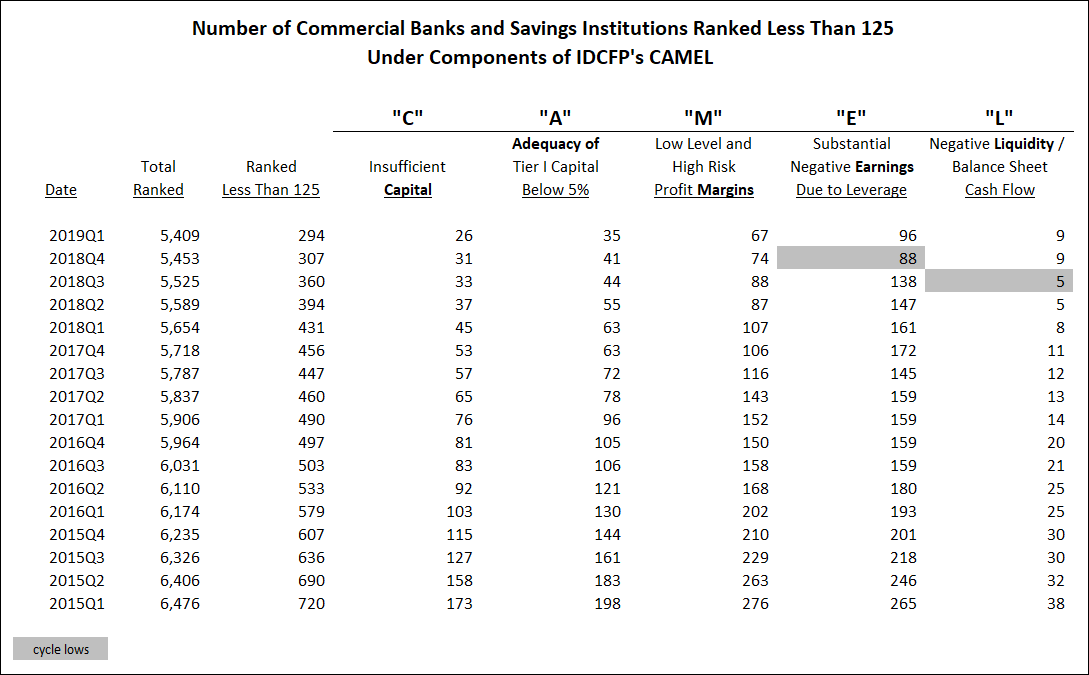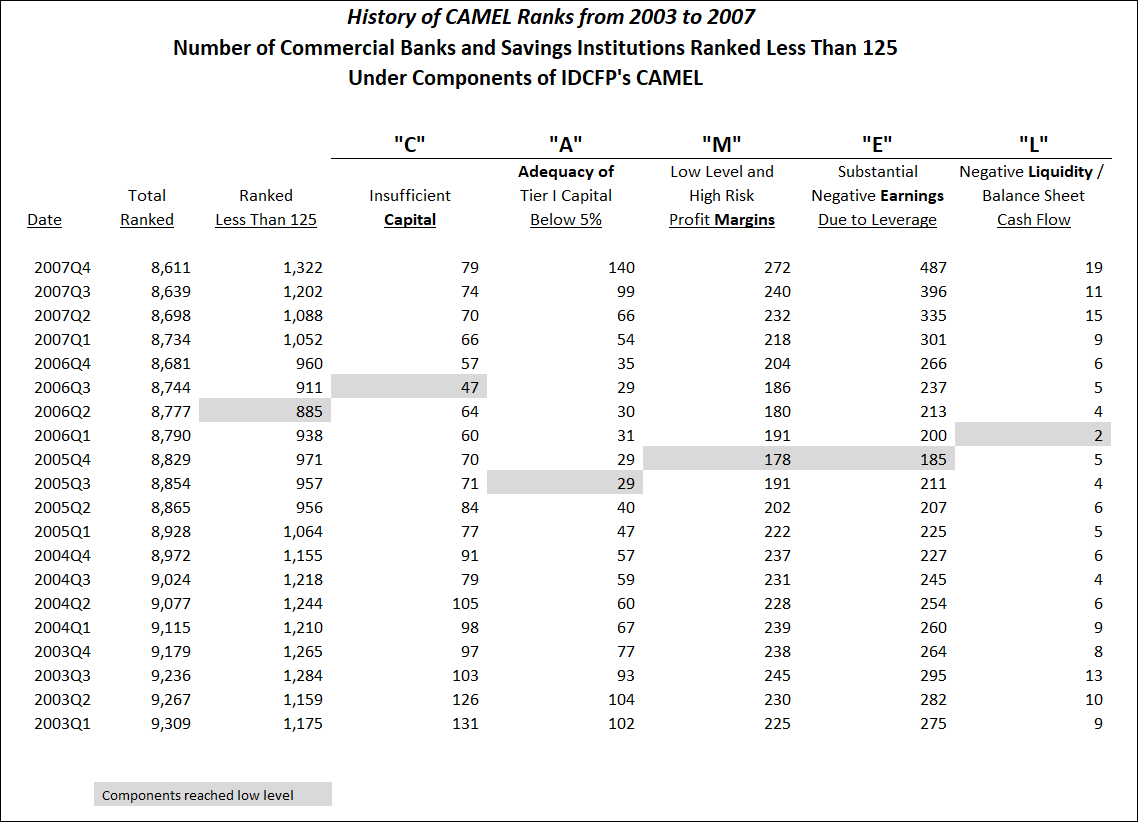How Assessing Adequacy of Capital Determines Risk
IDC Financial Publishing (IDCFP) uses the acronym CAMEL to represent the financial ratios we use to evaluate the safety and soundness of commercial banks, savings institutions and credit unions. This article explains how we measure adequacy of capital in banks and savings institutions as a component of our CAMEL ranking, and why it is valuable to monitor.
The “adequate capital” component of CAMEL measures the amount of adjusted Tier 1 capital.
- Tier 1 capital is adjusted by subtracting the amount of loan delinquencies (loans that are 90 days past due, non-accrual loans, plus repossessed assets) in excess of loan loss reserve.
- An adjusted Tier 1 capital ratio below 5% indicates insufficient capital and loan loss reserves to cover loan delinquencies and can result in an IDCFP rank less than 125.
Our CAMEL rating system of banks, savings institutions, and credit unions range from 300 (the top grade attainable) to 1 (the lowest). From the early 1990’s, through today, institutions using our safety ranks determined that ratings lower than 125 were deemed below investment grade. Institutions with adjusted Tier 1 capital ratios below 5% have insufficient capital relative to delinquencies and, therefore, receive an IDCFP rank below 125.
Forecasting the Next Banking Crisis - Updated with 2019Q1 ranks
Out of the 5,409 total commercial banks and savings institutions, we have identified 294 ranked less than 125 in the first quarter of 2019. When we see the number of these poorly rated banks reach a low and begin to rise, either in the total institutions ranked or by CAMEL component, this indicates the potential for a future crisis.
Table I illustrates the trend of two CAMEL components reaching lows when examining commercial banks and savings institutions ranked less than 125 by IDCFP (see Table I). The total number of institutions, plus other CAMEL components, however, are still declining as of the first quarter of 2019.
- The number of risky institutions reached a new low of 294 in the first quarter of 2019.
- The “C” component, or institutions with insufficient capital, fell to a new low of 26 in the first quarter of 2019.
- The “A” component represents institutions lacking adequacy of capital to cover delinquency with less than 5% risk-adjusted capital. These institutions declined to a new low of 35 in the first quarter of 2019.
- The “M” component, which uses margins as a measure of management reached a new low level of 67 banks in the first quarter of 2019.
- The “E” component represents institutions exhibiting negative earnings or returns on financial leverage (ROFL). These banks hit a low of 88 in the fourth quarter of 2018 and rose to 96 in the first quarter of 2019.
- Finally, the “L” component represents negative liquidity. The number of banks ranked below 125 with negative balance sheet cash flow and high loan delinquency reached a low of 5 in the third quarter of 2018, then rose to, and remained at 9 in the first quarter of 2019, which is an indication of risk.
To forecast a banking crisis, the number of all banks ranked less than 125, as well as those in each component of CAMEL, must reach a low and begin to increase. With only the “E” and “L” components currently showing this trend, the next few years are forecast to be free of major problems with no crisis on the horizon.
Table I

Early Warning Indicators in History
In history, we have seen banks in total and the components of CAMEL hit lows and begin to rise, which forecast the banking crisis of 2008. The number of commercial banks and savings institutions ranked below 125 reached a low in the second quarter of 2006, two years before the crisis. More importantly, leading up to that point, the number of banks in 4 out of the 5 components of CAMEL also reached lows from the third quarter of 2005 through the first quarter of 2006, and then began to rise.
As seen in Table II below,
- The number of high-risk institutions reached a new low of 885 in the second quarter of 2006 and steadily rose in subsequent quarters.
- Commercial banks and savings institutions with insufficient capital reached a low number of 47 institutions in the third quarter of 2006 and began to increase in subsequent quarters.
- The number of financial institutions with less than 5% adequacy of capital reached a low count of 29 in the third quarter of 2005, and then increased.
- The number of banks and savings institutions with a lack of profitability, or low and unstable margins, reached a low of 178 in the fourth quarter of 2005, and subsequently rose.
- The number of banks and savings institutions with severe negative earnings due to financial leverage reached a low number of 185 in the fourth quarter of 2005, and then increased.
- Finally, the number of institutions with high loan delinquency and negative balance sheet cash flow, or negative liquidity, reached a low of 2 in the first quarter of 2006, and then increased.
In addition to the total number of banks ranked less than 125, all 5 categories of rank provided a timely indication of risk and potential failure. All these elements combined displayed a trend where the number of institutions reached a low and subsequently increased and forecast the banking crisis of 2008.
Table II

As seen in history, the increase in the number of financial institutions with an IDCFP CAMEL rating below 125, or below investment grade, forecast the bank financial crisis a few years later. Our ranks are critical for investors to monitor financial institutions and prepare for potential risk.
To view our products and services please visit our website at www.idcfp.com. For further information about our CAMEL ranks, or for a copy of this article, please contact us at 800-525-5457 or info@idcfp.com.
John E Rickmeier, CFA, President, jer@idcfp.com
Robin Rickmeier, Marketing Director
